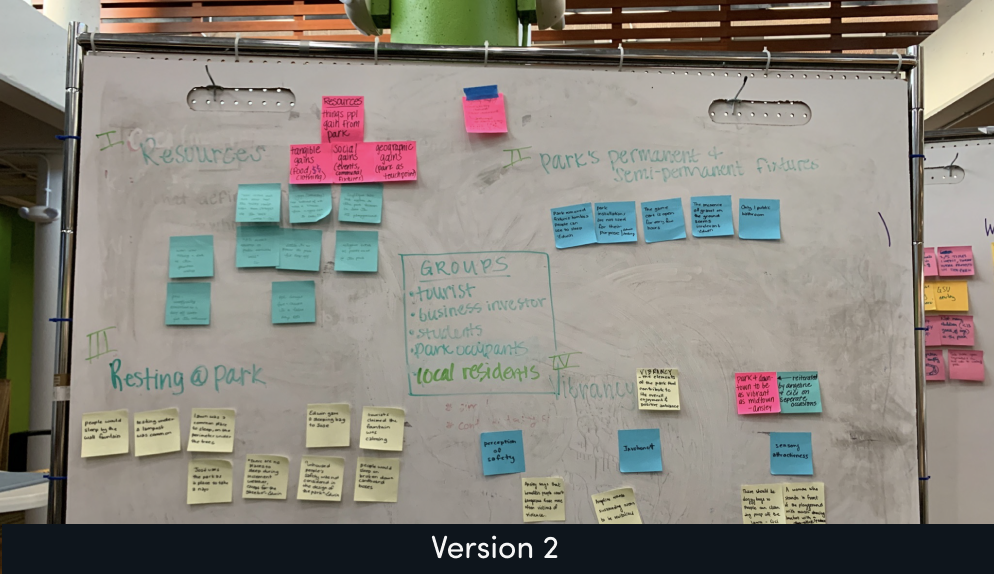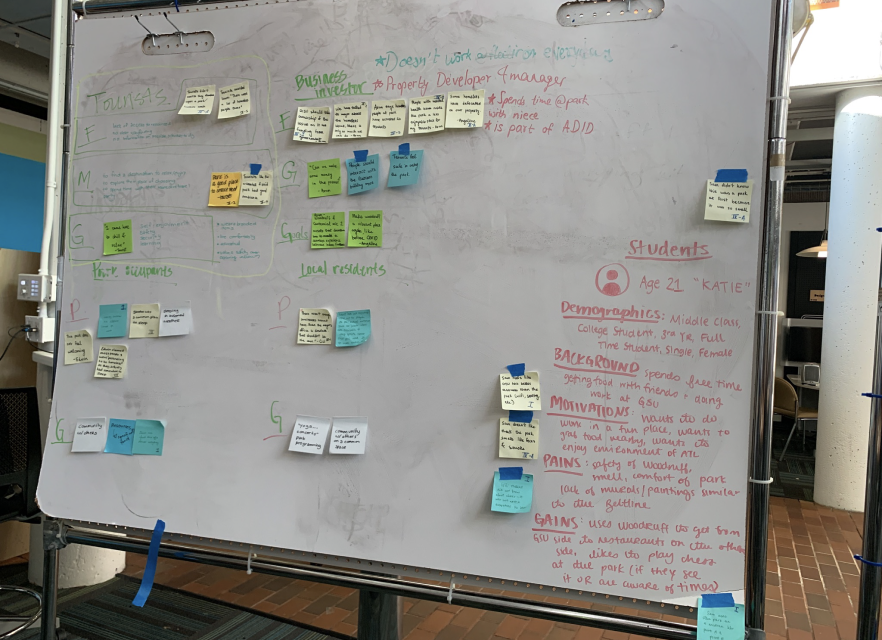Relationship Mapping in Woodruff Park
Design Bloc


Woodruff is a park located in the Atlanta downtown area. Our lead has partnered with the park management with a goal of understanding the underlying relationships and needs of the space. Key facts are listed below:
Founded by Robert W. Woodruff (former Coca Cola president)
Estimated 5 million guests each year, brings in additional crowd ( 10,000 annually) for special events
Located at 91 Peachtree St NW , Atlanta GA 30303 with a size of 6 acres
Maintained by A-DID (Atlanta Downtown Improvement District)
Intended to be a flexible space for large crowds, targeting students, business workers, and for tourists of events
Our goal is to collaborate with a community of individuals who, we should consider living experts to gain a sense of cognitive empathy for their experience and thereby identify opportunities to introduce improvement.
We were encouraged and equipped to stay objective and defer assumptions, and reminded that as designers we are responsible for the effects of the community we engage with.
Before we began to conduct ethnography, we were lectured on being aware of our frame of reference and reminded that we must approach this project in the lens of Co-Design.
A partner and I went to the park on a Saturday evening to conduct casual interviews and observe the park to help build contextual awareness of the ecosystem. We observed for an hour and a half and talked to 3 parties of visitors.

Our studio class visited Woodruff Park and was guided through the park by its staff. We were then given the opportunity to ask questions about the park as well to validate our understanding of the park.

Given our new-found context and information, we returned to the park on a Friday afternoon to conduct more interviews and observe. We observed for an hour and a half and talked to 4 parties of visitors.

High level reflections of our past observations.
As a team, we began to write down our notes and findings from our collective observations. We then began to affinity map to uncover initial common themes within the park.

Based on our initial themes, we conducted additional interviews, both from the park staff partnered with our studio and organically with visitors of the park. We were able to then categorize visitors into general buckets and affinity map in regards to common themes.


Our team then used our existing affinity map to guide creating psychographic personas based on our prior interviews and research. Psychographic personas are concerned with motivation, goals, and pains.

We then used ecosystem mapping to map the relationships between our personas. Our goal was to understand the current state of the system or community. In the process, we found that from our previous affinity mapping, we were missing a persona category.
The service provider persona refers to visitors who interact with Woodruff Park with the intention of providing a service to other visitors.
In addition, we found that GSU students did not have any traditional relationships with the other defined personas.

Given that the team and I had worked to gain a more thorough contextual understanding of the park, we defined a research scope. This was to help our team make sense of our existing data and identify what else we needed to uncover. We could not have identified a scope earlier in our process as we did not have an understanding of the park and its community.
Since our scope revolves around service-oriented relationships, our team wanted to clearly define "service" to avoid misinterpretaion.
Our team decided to only focus on the Service Provider and the Service Receiver for our scope.
However, our prior work was important for it allowed us to define and understand that if service providers exist, service receivers must also exist as an entity. In addition, it allowed us to understand the larger ecosystem at hand. We found that individuals who were service receivers and providers could also fall into our other persona categories.
To further define service providers and receivers, we created community profiles about real individuals we interviewed in the Woodruff Park ecosystem who fall into either persona.
While creating the community profiles, we simultaneously finalized the psychographic personas of a provider and receiver (motivations, goals, pains).
We created a story map mapping the basic interactions between a service provider and receiver in Woodruff Park. We identified key stages and the physical space each stage is commonly associated with.


Though our research we found that the relationship between providers and receivers is symbiotic. They need one another in other to be successful in their goals.
Woodruff Park staff regulates Service Providers, offering permits and assistance in providing resources to people in the park.
Service Providers often compete with local businesses by providing free resources instead of paid services by local businesses.
Over the course of this semester, I as a designer had to ask questions and be in situations that I didn't immediately feel comfortable with. I believe I grew personally as a designer during the course of this project. I enjoyed the collaborative nature of this studio class and how we were able to question or validate our findings based on the experiences of other teams.
I am incredible grateful for the many students I worked with during the course of the project. It was a wonderful experience challenging each others assumptions and stitching together a working model of the park and its relationships. I feel comfortable with field research and have added many new tools and methods to my design research toolkit.